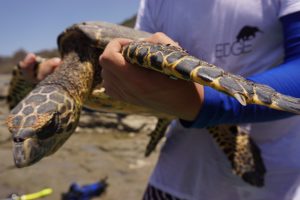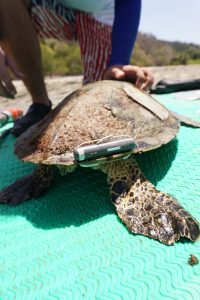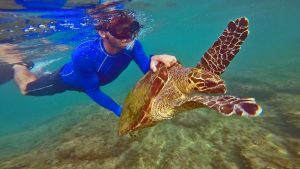Daniel Arauz, part of the first cohort of National Geographic Photo Ark EDGE fellows, talks about his work to understand and help save critically endangered hawksbill sea turtles.
Across millions of years, sea turtles have established their migration routes across the oceans of planet earth. Most of the movements occur seasonally, with individuals moving between nesting and foraging grounds. Leatherbacks (Dermochelys coriacea) hold the longest migration record, with some individuals moving more than 10 000 miles across the Pacific Ocean from Asia to the United States looking for jellyfish. Green turtles (Chelonia mydas) on the other hand, have shown constant migrations between oceanic islands in the Pacific Ocean hundreds of miles apart. However, mainly due to their scarcity, the movements of hawksbill turtles (Eretmochelys imbricata) in the Eastern Pacific (EP) Ocean are still not well understood. Recent studies suggest that hawksbills in the EP exhibit a higher degree of fidelity to their natal area than other species with restricted or nonexistent migrations. However, specifically how far they disperse from rookeries to foraging grounds is still uncertain.

As part of my research as a National Geographic Photo Ark EDGE Fellow, I am monitoring the status and movements of juvenile and sub-adult hawksbill sea turtles across different foraging grounds in Costa Rica. Due to an increasing number of sightings and foraging grounds discoveries along the Pacific coast of Costa Rica, and the suggestion that hawksbills don’t travel large distances between rookeries and foraging grounds, there is a developing notion between scientists that other important rookeries are yet to be discovered in Costa Rica, with only a handful of hawksbill nests reported during previous seasons.
Using Vemco’s acoustic telemetry technologies for aquatic animals, my team has successfully tagged twelve different hawksbill sea turtles at foraging grounds. Each tag emits a specific sound at a frequency not detected by turtles or humans. These sounds can be picked up either by listening stations or “receivers” that are set up at suspected stops along the migration route or by researchers on board a vessel using a special hydrophone to detect the signals. By the end of my project, I expect to have a detailed map of hawksbill sea turtles foraging areas, as well as how much time they are spending at each foraging ground. This information will be presented to local authorities and other stakeholders, with the hopes of strengthen management regulations in those areas more frequented by this species.

Hawksbill sea turtles are listed as critically endangered under IUCN’s Red List of Threatened Species. In the EP, where the species was once close to regional extirpation, there’s an estimate of only five hundred nesting females left. A recent paper on research priorities for immature sea turtles highlights the need for more information on juvenile sea turtle habitat use to help address existing management questions. Importantly, the survival of young hawksbills can have a significant effect upon population growth, helping us prevent the extinction of this emblematic and important creature.
To learn more about my research, follow my expedition at National Geographic’s Open Explorer: https://openexplorer.nationalgeographic.com/expedition/costaricasmarinefauna

Daniel Arauz is a field biologist and project coordinator for the Rescue Center for Endangered Marine Species (CREMA) in Costa Rica. As a biologist and professional diver, Daniel Arauz has been involved in marine conservation since a very young age. Since 2017 he has managed a sea turtle monitoring program in coastal communities where he promotes environmental education, science, and sustainable fisheries practices to protect the habitat of the critically endangered hawksbill sea turtle. In 2018 Daniel was selected as part of the first cohort of National Geographic Photo Ark EDGE fellows, which helps young conservationists in protecting evolutionarily distinct and globally endangered species.
To learn more about Daniel’s work or to become a volunteer, you can contact him through CREMA’s Facebook.